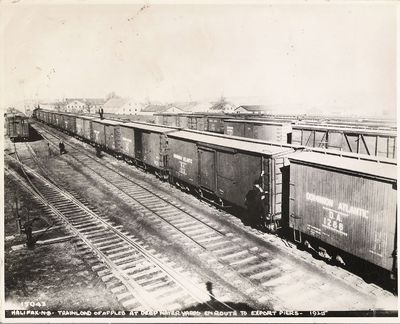Dominion Atlantic Railway Digital Preservation Initiative - Wiki
Use of this site is subject to our Terms & Conditions.
Apple Trains

Apple Trains
Apple freight was the DAR's most important cargo. Apple traffic helped build the DAR and the DAR built the Valley's apple industry from a small side-crop to a major international export. Apple traffic averaged between 1 and 2 million barrels a year with the record crop in 1933 hitting 3,673,678 barrels.(3) Britain was the world's largest importer of apples and in the 1930s, one out of every ten apples sold in Britain came from from Annapolis Valley farms via the DAR. Over 150 apple warehouses lined the route of the DAR.(2) However, the loss of the British export market during World War Two crippled the apple industry and greatly reduced DAR freight traffic from the 1940s onward. The hundreds of apple warehouses closed, although the surviving volume of apple traffic processed at centralized apple processing plants such as Scotia Gold at Coldbrook and Graves in Berwick remained important DAR customers in later years.
Operations
From September to April during the peak decades of the apple industry, apples were loaded at 150 apple warehouses along the DAR. Local trains brought them to Kentville to be marshalled into freights bound for steamships in Halifax. In peak seasons, this produced massive double-header 50 boxcar freight specials, as many as six special trains per weekend, requiring an extra switcher locomotive in Kentville and extra CPR vans from Montreal.(1) Apple trains also served the vinegar plants and apple evaporators such the Berwick Evaporator which ran all through the winter. This heavy traffic had to be maintained right through heavy winter snow conditions.
Rolling Stock
The DAR used standard 36 and 40 foot boxcars in summer and early fall. During the winter when freezing temperatures arrived, a large fleet of specially adapted insulated boxcars were used for apple service, the 69900 series, as well as refrigerated boxcars with charcoal heaters.
Structures
See main article Apple Warehouses
Apple warehouses, where apples were packed, stored and shipped, were the centrepoint of apple operations. Evaporators, like the Berwick Evaporator and a dozen others were also important customers for apple trains as well as a few vinegar and cider plants. In later years, large central processing plants like Scotia Gold in Coldbrook and Graves in Berwick remained important customers.
Apple train in Halifax in 1925.
- CDCDA Apple Warehouse Thumb.jpg
Centreville Station surrounded by apple warehouses.
Apple barrels piled by the station at Centreville.
A double header apple train in Centreville.
Article about the Berwick Apple Evaporator, 2006.
References and Footnotes
(1) Kentville Advertiser, Mar. 25, Sept. 9 and Sept. 16, 1937
(2) Some Economic Aspects of the Apple Industry in Nova Scotia by Willard Longley
(3) Valley Gold by Ann Hutton





